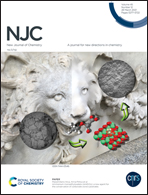A detailed quantum chemical investigation on the hydrolysis mechanism of osmium(iii) anticancer drug, (ImH)[trans-OsCl4(DMSO)(Im)] (Os-NAMI-A; Im = imidazole)†
Abstract
Detailed hydrolysis mechanism of osmium(III) anticancer drug, (ImH)[trans-OsCl4(DMSO)(Im)] (Os-NAMI-A; Im = imidazole, DMSO = dimethyl sulfoxide) has been investigated using density functional theory (DFT) in combination with CPCM solvation model. In the first hydrolysis step, faster aquation is observed in the case of DMSO hydrolysis from Os-NAMI-A in comparison to the chloro ligand having activation Gibbs free energy (ΔGaq) value of 24.66 kcal mol−1, which is in good agreement with the experimental results. On the other hand, the second hydrolysis is mainly performed via the first chloro ligand hydrolysed Os-NAMI-A to form cis-[OsCl2(H2O)2(DMSO)(Im)]+ (P-2B). However, the hydrolysis of cis-diaquated Os-NAMI-A [OsCl3(H2O)2(Im)] (P-2A) shows enhanced feasibility in the third hydrolysis step with the lowest activation Gibbs free energy (17.27 kcal mol−1) and the rate constant value is computed to be 1.34 s−1. Additionally, it is observed that hydrogen bonding plays an important role in stabilizing the intermediates and transition states. Furthermore, calculated net atomic charges based on natural population analysis show charge redistribution during hydrolysis reactions.
![Graphical abstract: A detailed quantum chemical investigation on the hydrolysis mechanism of osmium(iii) anticancer drug, (ImH)[trans-OsCl4(DMSO)(Im)] (Os-NAMI-A; Im = imidazole)](/en/Image/Get?imageInfo.ImageType=GA&imageInfo.ImageIdentifier.ManuscriptID=D1NJ00783A&imageInfo.ImageIdentifier.Year=2021)


 Please wait while we load your content...
Please wait while we load your content...